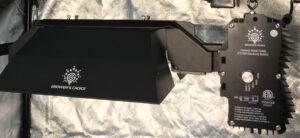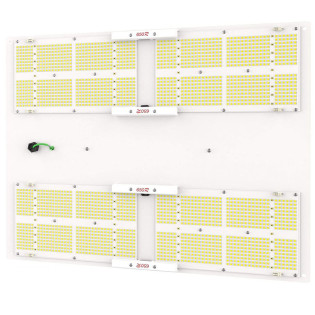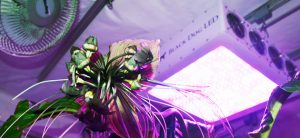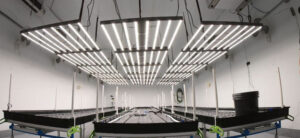
There are an abundance of different grow light certifications and it can get overwhelming. What do you need, and what don’t you need? As we’ll explain in this quick article, it depends on your grow.
When it comes to indoor growing, your lights need to be protected from a wide range of conditions - moisture, dust, etc. But, some listings even take into consideration how the grow light performs.
No matter how you grow, we have lights with the certifications you need. And, we have the knowledge to help you pick the right one.
Understanding IP Ratings Of Grow Lights & Lighting In General

To make breaking down the different IP Ratings you’ll find on our grow lights pages, just think of it like this: these ratings classify the degree to which a light is protected from foreign objects, such as water or dust, entering the electrical components.
Grow rooms and grow tents have very moist and dusty conditions. Using the right lights for your room will prevent premature failure, or worse - a grow room fire.
IP ratings consist of two numbers, and there are so many. But all you need to be concerned about are IP 54, 65, and 66.
The first number following the “IP” dictates how much protection the electrical components have from dust or other foreign objects. The second number indicates the degree of protection from water droplets or even sprays.

What Is An IP54 Rated Grow Light?
Simply put, a product rated IP54 approved means that while the light is safe from dust ingress that could interrupt or harm normal operation, it is not fully dust-tight.
It also means that it’s protected against solid objects, along with spraying water with a nozzle of 6.3mm in any direction.
What Is An IP65 Rated Grow Light?
One of the most common ratings you’ll find on an LED grow light is IP65.
This means the grow light is safe to use in wet and humid areas, which is exactly what you’ll experience in the grow room environment!
On top of being safe, it makes cleaning your grow room and spraying your plants easy, as the housing will protect the unit from any moisture getting in.
These are also protected from dust, just like grow lights rated at IP54.
What Is An IP66 Rated Grow Light?
IP66 rated grow lights are very similar to IP65 - they just have a bit more protection from water.
In testing the safety of the light, these higher rated lights are protected from heavier streams of water - a nozzle with higher pressure.
What Is An IP67 Rated Grow Light?
One final IP rating we want to cover is IP67. This is a unique rating in that unlike the aforementioned IP54, IP65, and IP66 ratings, the IP67 can be fully immersed in water up to 1 meter in depth for up to 30 minutes.
This basically means it has more water protection than you’d really need in a grow room or horticulture setting.
But you can never be too safe with indoor growing, especially when it comes to your lighting investment and of course, your crop investment!
Of course, the “6” in IP67 means grow lights rated with this are protected from dust ingress as well. And, the light is protected from jet streams of water too.
What Does The DLC Listed Grow Light Certification Mean?
Efficiency is why so many growers opt for LED’s - but not all of these lights are created equal in terms of energy efficiency.
Some consume far less energy than others, while putting out an intense, sustainable light for your plants. These lights are recognized by the DLC as the best LED grow lights when it comes to performance, safety, and reliability standards.
In some states, you may be required to use DLC listed grow lights in order to get a rebate for energy efficiency at your operation.
What Are The Requirements To Get DLC Listed?
First off, this certification is reserved only for LED grow lights. There are a few different areas DLC looks at when testing lights before listing them under their certification. These include:
- Efficacy great than 1.9umol/J between 400-700nm
- Sustainability, with impressive light maintenance of at least Q90 > 36,000 hours photon flux maintenance
- Certain design requirements, such as omitting the use of any externally-supplies active cooling systems (circulating-liquid and forced air)
- A long driver lifespan of at least 50,000 hours
- A warranty of at least 5 years
This is not everything, though. The light must also be certified by a relevant safety inspection organization in either the US or Canada. This can be UL, IP, etc.
What’s The Difference Between UL Listed & ETL Listed Grow Lights?
Two pretty similar certifications that get compared often are UL Listed and ETL Listed. Simply put, these are just two more organizations that test the safety and efficacy of grow lights.
Electrical Testing Labs (ETL) was actually founded by Thomas Edison, and is over 100 years old. UL Listing, on the other hand, is provided by UnderWriters Laboratories.
These companies are the same in that they are both NRTLs - short for Nationally Recognized Testing Laboratories. This means both of these listings indicate a grow light is safe to use in a workplace. They will keep you, any of your employees, and your crop protected.
So, if you’re a commercial grower worried about staying compliant with OSHA, you definitely need UL or ETL Listed grow lights.
What Does CSA Listed Mean For Grow Lights?
Finally, CSA listed grow lights are tested by the CSA Group - a Canadian agency that has been involved in the design, prototyping, and testing of LED’s since 2008.
They’re similar to other agencies in that they test for the safety and reliability of your horticulture lamps - but there are some cool things they test for that others do not.
For example, they can test to ensure the UV, IR, and deep blue wavelengths of your diodes are safe for human skin!
Final Thoughts On Grow Light Certifications
In closing, check the certifications of the grow light you’re purchasing - even if you aren’t a commercial grower.
The last thing you want is to invest in an LED that won’t stand the test of the time, or worse, is unsafe - especially if you’re growing in the home.
























